#Grand Duke Nikolay Nikolaevich
Explore tagged Tumblr posts
Photo
There are four individuals I do not recognize. Actually, this is an impressive gathering of Grand Dukes and Duchesses. I have included all the names of individuals in the group that I recognize on the tags.
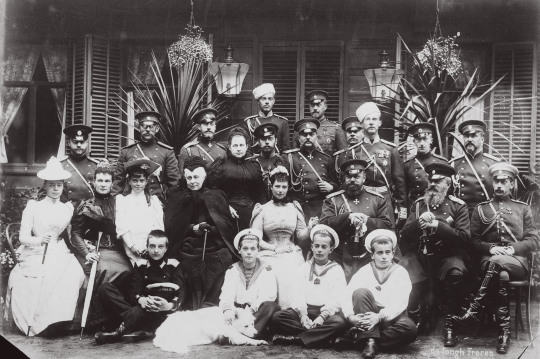

Emperor Alexander III surrounded by family
#Grand Duke Konstantin Konstantinovich#Grand Duke Sergei Mikhailovich#Grand Duke Nikolay Nikolaevich#Grand Duke Vladimir Alexandrovich#Grand Duke Dmitry Konstantinovich#Duke Peter of Oldenburg#Grand Duchess Xenia Alexandrovna#Grand Duchess Maria Pavlovna the Elder#Grand Duchess Helena Vladimirovna#Grand Duchess Alexandra Iosifovna#Empress Maria Alexandrovna#Emperor Alexander III#Grand Duke Mikhail Nikolaievich#Grand Duke Pavel Alexandrovich#Grand Duke Alexey Mikhailovich#Grand Duke Mikhail Alexandrovich#Grand Duke Andre Vladimirovich#Grand Duke Boris Vladimirovich#Olga
103 notes
·
View notes
Text

Portrait of Grand Duke Nikolai Nikolayevich of Russia (1831-1891). Unknown artist.
6 notes
·
View notes
Text

Emperor Nicholas I (1796 - 1855) and Empress Alexandra Feodorovna (1798 -1860 - nee Princess Friederike Luise Charlotte Wilhelmine of Prussia
Nicholas I, the Iron Tzar, and his sons
This couple was the first “Nicholas and Alexandra” in the Romanov Dynasty. They were Nicholas II's great grant-parents.
It was said that he was the best-looking man in Europe. She was tall and fair and enjoyed jewels, gowns, and balls. They loved each other, and their union was not unhappy, but he did not remain faithful to her (after he died, his last mistress was employed as Alexandra’s lectrice, and they became friends.) Nicholas and Alexandra had seven children, four sons, and three daughters. Those four sons would ensure that the generation of Romanovs following them would not want for male heirs. As a matter of fact, there would be too many Grand Dukes, making it necessary for his grandson, Alexander III, to change the Pauline laws, re-defining who would be considered a Grand Duke or Duchess, among other things (only grandsons/grandaughters of a Tzar would be Grand Duke/Duchesses; great-grandsons and so on would be Princes and Princesses of the blood).

Nicholas I with his four sons: Tsarevich Alexander Nikolayevich (1818 - 1881 - future Alexander II), Grand Duke Konstantin Nikolayevich (1827 - 1882), Grand Duke Nikolay Nikolayevich (1831 - 1891), and Grand Duke Mikhail Nikolayevich (1832- 1909.)
According to the literature, Nicholas raised his two elder sons very strictly but had more of a paternal relationship with the younger two. His priority was to bring them up so that they were true soldiers and so that when Alexander inherited the throne, the other three would help and support him. And they did. Nicholas I adored his daughters and was devastated when his youngest daughter Alexandra (better known as Adini), died. (His daughters would be discussed in another post.)
Below are the sons of Nicholas I and their spouses:

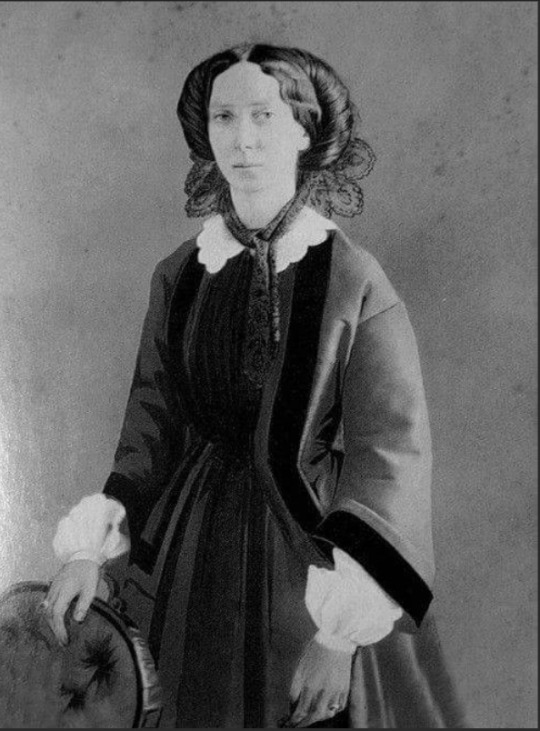
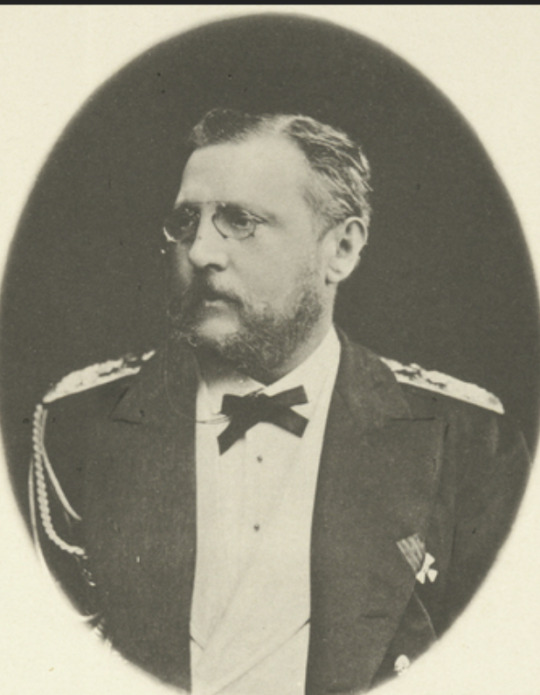
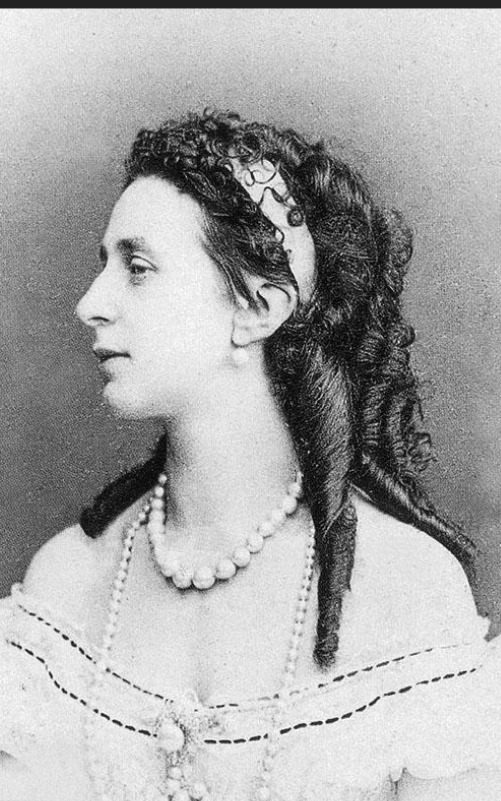

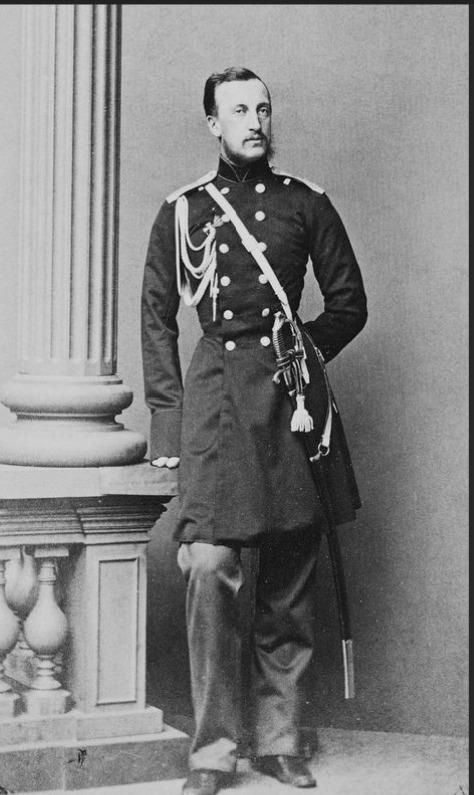

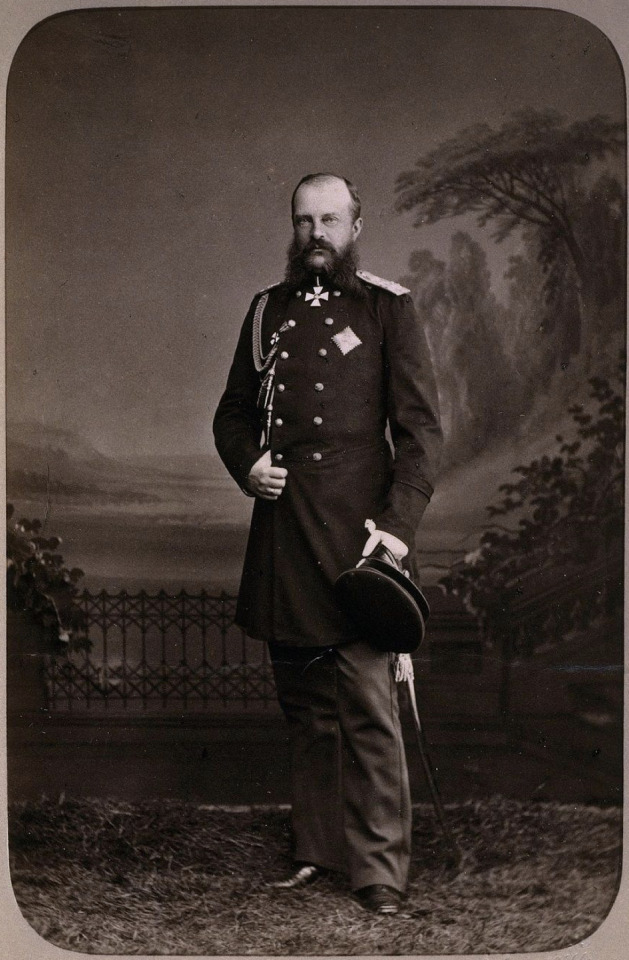
1. Emperor Alexander II and his first wife Empress Maria Alexandrovna (born Princess Wilhemine Marie of Hesse); Issue listed below (Only legitimate issue surviving to adulthood listed; not in birth order)
Grand Duchess Marie
Grand Duke Nicholas Alexandrovich
Alexander III
Grand Duke Vladimir
Grand Duke Alexei
Grand Duke Sergei
Grand Duke Pavel
2. Grand Duke Konstantin Nikolayevich and Grand Duchess Alexandra Iosifovna (Princess Alexandra of Saxe Altenburg); Issue listed below (Only legitimate issue surviving to adulthood listed; not in birth order) - They would be known as the "Konstantinovichi"
Grand Duke Nicholas
Grand Duke Konstantin
Grand Duke Dmitry
Grand Duke Vyacheslav
Grand Duchess Olga
Grand Duchess Vera
3. Grand Duke Nikolay Nikolayevich (the Elder) and Grand Duchess Alexandra Petrovna of Russia, born Duchess Alexandra Frederica Wilhelmina of Oldenburg. Issue listed below (Only legitimate issue surviving to adulthood listed; not in birth order); Known as the "Nikolayvichi”
Grand Duke Nicholas Nikolayevich
Grand Duke Peter Nikolayevich
4. Grand Duke Mikhail Nikolayevich and Grand Duchess Olga Feodorovna (nee Princess Cecilie of Baden) Issue listed below (Only legitimate issue surviving to adulthood listed; not in birth order) They were known as the "Mikhailovichi" (although they preferred to be called the "Michels;" the family called them the "Wild Caucasians" because they grew up in the Caucus and had strong opinions that they voiced loudly)
Grand Duchess Anastasia Mikhailovna
Grand Duke Nicholas Mikhailovich
Grand Duke Mikhail
Grand Duke George
Grand Duke Alexander
Grand Duke Sergei
Grand Duke Alexei
The children and grandchildren of these couples would be directly involved in one way or the other in the Great War, the Russian Revolution, the Civil War in Russia, and the overthrow of the monarchy and the Romanov Dynasty. Some would lose their lives, others would lose children, brothers, and spouses, and all would lose their country, status, and privileges.
#russian history#romanov dynasty#imperial russia#Emperor Nicholas I#Emperor Alexander II#Grand Duke Konstantin Nikolayevich#Grand Duchess Alexandra Iosifovna#Grand Duke Nikolay Nikolayevich#Grand Duchess Alexandra Petrovna of Russia#Grand Duke Mikhail Nikolaevich#Grand Duchess Olga Feodorovna#vintage photography
95 notes
·
View notes
Text
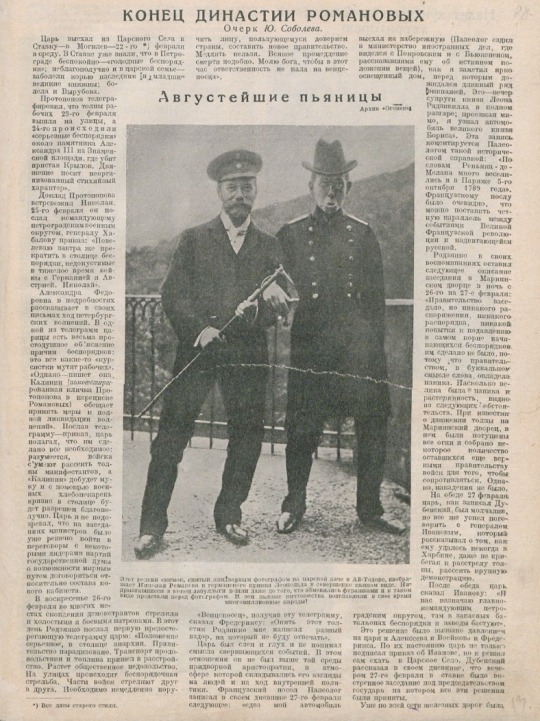
On the photograph: on the left Nicolas II (Nikolai Alexandrovich) and on the right German Prince Leopold, location Ai-Todor Palace in Crimea.
The image is a page from an archival issue N12 of the weekly journal Ogonek, 1925. The article was written by Y. Sobolev. The article describes the events surrounding the abdication of Nicolas II and then him being under home arrest in Alexandrovsky Palace, his move to Tobolsk and then to Ekaterinburg. The last two events are just mentioned without any details. There is also one line saying that on 16 July the execution sentence was carried out. At the end of the article it is mentioned that self-announcement of Grand Duke Kirill the Emperor of Russia and ''appointment' of Nikolai Nikolaevich the guardian of the Russian throne cannot be taken seriously.
It appears that one page of the article is missing.
It is not quite clear why this particular article was published in 1925 and what it aimed at.


On the images: pages of the article on Nicolas II by Y. Sobolev. (Ogonek weekly journal, issue N12, 1925)
#romanovs#research#seraphima bogomolova#investigation#nicolas ii#murder mystery#Ogonek#articles#1925
24 notes
·
View notes
Text

Georgiy Maximilianovich (not Mikhailovich as it says here!) of Leuchtenberg with his daughter, Elena Georgievna.
Elena's mother was Anastasia "Stana" of Montenegro, to whom she bears a strong resemblance. After her parents' divorce, Elena's mother married Grand Duke Nikolai "Nikolasha" Nikolaevich.
28 notes
·
View notes
Text

Ivan Konstantinovich Aivazovsky (1817-1900)
Galata Tower in the Moonlight. 1845. Oil on canvas. 52 x 80 cm
EXPERT CONCLUSION: State Russian Museum (expert Goldovsky G.N., Krylov N.N.)
PROVENANCE: meeting of Nicholas I
SIGNATURE AND DATING: at the bottom right "Aivazovsky // 1845"
PUBLICATIONS: N.P. Sobko, Dictionary of Russian Artists, St. Petersburg, 1893, Volume I, p. 300; Goldovsky G.N. Ivan Aivazovsky. Great mariner. Russian Museum, 2017, p. 122
The Galata Tower in the moonlight is one of the earliest species of Aivazovsky in Constantinople. Exceptionally detailed, beautifully balanced and illuminated with such sophistication that every distant tree, roof and sail adds another layer of depth to the canvas, this is an outstanding example of the high standards it was capable of. Biographer Nikolai Sobko notes that in 1845 Aivazovsky drew two views of Constantinople "from the Golden Horn and from the side of the Galata Tower". Both were presented to Emperor Nicholas I in November of the same year by order of the President of the Academy. After that, Aivazovsky was appointed by the emperor to draw views of four Black Sea ports, Sevastopol, Odessa, Feodosia and Kerch (see N.P. Sobko, Dictionary of Russian Artists, St. Petersburg, 1893, Volume I, p. 300).
Aivazovsky visited Constantinople several times during his life and almost every year returned to this topic in his work. However, the real canvas was painted from his very first impressions of the city when he visited it in his youth in April 1845 at the end of a tour of Asia Minor, the Aegean Sea, the Levant and Troy with Grand Duke Konstantin Nikolaevich. His next visit did not take place until 1857. At that time, Aivazovsky made dozens of sketches of the city, which he turned into larger paintings in his studio in Feodosia. A number of these early species of Constantinople were exhibited in Feodosia in the spring of 1846 (Coffee shop at the Ortak Mosque, Constantinople, 1846). Their brilliance was immediately obvious. As Valentin Serov's father wrote: "I never even knew that he draws human figures so well; there is so much life everywhere, so much brilliance, and now there is no more exaggeration that people used to wear against him... In general, I cannot imagine that there is an artist in all of Europe who is superior to Aivazovsky in this type of painting" (G.Caffiero, I.Samarine, Seas, Cities and Dreams, p.42).
Ivan Konstantinovich Aivazovsky (1817-1900) is a world-famous outstanding Russian painter, a master of seascape. In 1833-1839 he studied at the Academy of Arts, where his successes were repeatedly awarded. In 1840, AKH went abroad as a pensioner. During his retirement, he visited many European countries. Upon his return (in 1844), he was awarded the title of academician of marine species and appointed painter of the Main Maritime Staff. In 1847, he was awarded the title of professor. Since 1848 he lived in Feodosia. In 1865, he opened an art school at his workshop. He took an active part in the improvement of the city. In 1880, he opened an art gallery in Feodosia. In 1881 he was awarded the title of honorary citizen of Feodosia. Traveled all over the world. Honorary member of several European Academies of Arts. He had numerous awards from Russia and many foreign countries. Aivazovsky's works are highly valued all over the world and are kept in many foreign and Russian museums.
Moscow Auction House
5 notes
·
View notes
Text

Beauty and Performance review
Bistri of Perchina (Bistri Perchino)
Sire: Almaz Perchino
Dam: Ptaschka Perchino
Male
6 Jun 1901
#Breeder: Grand Duke Nikolay Nikolaevich
#Owner: Joseph Thoma#OWNER
Imported from Russia in 1904
US CH - USA/American Conformation Champion
2 notes
·
View notes
Photo


Playing at Tsar
There is one subject upon which writers in all Russian papers agree, from the official Pravda to the anti-Bolshevist Berlin Dni, and even to the monarchist Russkaia Gazeta. It is the manifesto of the Grand Duke Kyrill, who after a few years of 'guardianship of the Russian throne' suddenly styled himself Emperor of All Russia, to the lonely delight of a small group of personal followers. The Monarchist groups of Paris and New York, which include many prominent former statesmen and men of letters like Kuprin and Bunin, were not in the least influenced by the manifesto in their loyalty to the Grand Duke Nikolai Nikolaevich, in whom they recognize a leader, but not a Tsar. Nikolai Nikolaevich seems to possess a good deal more discretion, for he publicly declared that no Tsar should be chosen until this can be done on Russian soil and the chosen one can be Tsar de facto.
Pravda, which usually devotes many efforts to discrediting the anti-Bolshevist Russians abroad, thought the manifesto undeserving of more attention than a ten-line note in which Kyrill was called 'His Sans-Culotte Majesty.' Dni, the anti-Bolshevist organ in Berlin, printed an article entitled 'Violent Dementia,' which sufficiently describes its contents. In Paris Monarchist Russkaia Gazeta, V. Shulgin, the brilliant former Member of the State Duma, paraphrases the name of Kyrill's own newspaper, Faith and Loyalty, into 'Unbelief and Disloyalty.' The latter, he says are the only possible results of Kyrill's action. Neither the actual circumstances nor the personality of the self-styled Emperor are such as would create unanimous support for him. 'Here, abroad, a man with the Tsar's title can only be a source of new pain and new humiliation. We cannot bear to have a Tsar exist in the conditions of our exile. We could not, and ought to, be proud of Peter I, who carefully hid the splendor of his station under a carpenters blouse at Saardam; but it would be too painful to have a Tsar who would be Tsar to us and “His Highness” to every mail-carrier.'
Fianlly the ex-Empress Dowager Maria Feodorovna, who found refuge in her old age with her sister, the Queen Dowager of England, published an open letter to the Grand Duke Nikolai Nikolaevich, in which she disapproves of Kyirll's action because 'no man has yet been able to kill me the last ray of hope' that either Nicholas II or his brother Mikhail are still iving, and also because this is not the time, and Germany not the place, to chose a Russian Tsar. Nikolai Nikolaevich adds a few lines, in the curt, laconic style which once made him so popular in Russia as to excite Nicholas II's jealousy, to the effect he agrees with the august writer of the open letter.
The Living Age, 1924
#Grand Duke Kirill#Grand Duke Nicholas Nikolaevich#romanov#russian royal family#1920s#russian revolution#romanovs in exile#magazine article
23 notes
·
View notes
Text

Currently there is no known photos of the wedding of Tsar Nicholas II of Russia and Princess Alix of Hesse and By Rhine on 14 November 1894 ( 26 November 1894 N.S.) at the Grand Church of the Winter Palace.Of course they may still be in the Russian Archives,not yet released
On 19 April 1894, Tsarevich Nikolai Alexandrovich Romanov of Russia was at the wedding of Ernst-Ludwig Grand Duke of Hesse, to their mutual cousin,Princess Victoria Melita of Saxe-Coburg and Gotha. Nicholas had also obtained permission from his parents, Tsar Alexander III and Empress Marie Feodorovna, to propose to Ernst's younger sister, Princess Alix of Hesse and by Rhine.The Emperor and Empress had initially been opposed to the match. However, Nicholas, who had first met Alix a decade earlier in St. Petersburg when Alix's sister, Princess Elisabeth of Hesse and by Rhine, married Nicholas's uncle, Grand Duke Sergei Alexandrovich Romanov of was not to be dissuaded. Furthermore, Tsar Alexander's health was beginning to fail.
Shortly after arriving in Coburg, Nicholas proposed to Alix. However, Alix, who was a devout Lutheran, rejected Nicholas's proposal, as in order to marry the heir to the throne, she would have to convert to Russian Orthodoxy.However, Alix's cousin, Kaiser Wilhelm II of Germany, who had been at the wedding, insisted that it was her duty to marry Nicholas, despite her religious scruples.Elisabeth also spoke with her, insisting that there were not that many differences between Lutheranism and Orthodoxy. At the prompting of the Kaiser, Nicholas proposed for the second time, and she accepted.
On 1 November 1894, Alexander III died at Maly Palace, Livadia, leaving twenty-six-year-old Nicholas as the next Tsar of Russia. The following day, Alix, who had arrived at Livadia several days earlier in order to receive the dying Tsar's blessing, was received into the Russian Orthodox Church as Grand Duchess Alexandra Feodorovna.Alix had apparently expressed her wish to take the name Catherine, but decided to take the name Alexandra on Nicholas's request.
Guests
The groom's family
•The Dowager Empress Marie Feodorovna of Russia ~ mother of Nicholas II
•Grand Duchess Xenia Alexandrovna Romanova of Russia ~ sister of Nicholas ll
•Grand Duke Alexander Mikhailovich Romanov of Russia ~ brother-in-law and first cousin once removed) of Nicholas II
•Grand Duke Mikhail Alexandrovich Romanov of Russia, brother of Nicholas II
•Grand Duchess Olga Alexandrovna Romanova of Russia, sister of Nicholas II
•Grand Duke Vladimir Alexandrovich Romanov of Russia ~ paternal uncle of Nicholas II
Grand Duchess Marie Pavlovna Romanova of Russia (the Elder) ~ paternal aunt by marriage of Nicholas II
•Grand Duke Kyril Vladimirovich Romanov of Russia ~ paternal first cousin of Nicholas II
•Grand Duke Boris Vladimirovich Romanov of Russia ~ paternal first cousin of Nicholas II
•Grand Duke Andrei Vladimirovich Romanov of Russia ~ paternal first cousin of Nicholas II
•Grand Duchess Elena Vladimirovna Romanova of Russia ~ paternal first cousin of Nicholas II
•Grand Duke Alexei Alexandrovich Romanov of Russia ~ paternal uncle of Nicholas II
•Grand Duke Sergei Alexandrovich Romanov of Russia ~ paternal uncle of N0icholas II
Grand Duchess Elisabeth Feodorovna Romanova of Russia ~ sisters-in-law and paternal aunt by marriage of Nicholas II
•Grand Duke Pavel Alexandrovich Romanov of Russia ~ paternal uncle of Nicholas II
•Grand Duchess Alexandra Iosifovna Romanova of Russia ~ paternal grandaunt by marriage of Nicholas II
•Grand Duke Konstantin Konstantinovich Romanov of Russia ~ first cousin,once removed of Nicholas II
•Grand Duchess Elizaveta Mavrikievna Romanova of Russia ~ first cousin once removed by marriage of Nicholas II
•Grand Duke Dmitri Konstantinovich Romanov of Russia ~ first cousin once removed of Nicholas II
•Duchess Vera of Württemberg, first cousin once removed of Nicholas II (representing the King of Württemberg)
•Grand Duke Mikhail Nikolaevich Romanov of Russia ~ paternal granduncle of Nicholas II
•Grand Duke Nikolai Mikhailovich Romanov of Russia ~ first cousin once removed of Nicholas II
•Grand Duke Georgiy Mikhailovich Romanov of Russia ~ first cousin once removed of Nicholas II
•Grand Duke Sergei Mikhailovich Romanov of Russia ~ first cousin once removed of Nicholas II
•King Christian lX of Denmark ~ maternal grandfather of Nicholas II
•King George l of the Hellenes ~ maternal uncle of Nicholas ll
•Queen Olga of the Hellenes ~ maternal aunt and first cousin once removed of Nicholas II
•Prince George of Greece and Denmark ~ first cousin of Nicholas II
•Prince Valdemar of Denmark ~ maternal uncle of Nicholas II
The bride's family
•Grand Duke Ernst-Ludwig of Hesse and by Rhine ~ brother of Alexandra Feodorovna
•Princess Irene of Prussia ~ Sister of Alexandra Feodorovna
•Prince Henry of Prussia ~ brother-in-law and maternal first cousin of Alexandra Feodorovna (representing the German Emperor)
•Edward, Prince of Wales ~ uncle of both Alexandra and Nicholas (representing the Queen of the United Kingdom)
•Alexandra,Princess of Wales ~ aunt of both Alexandra and Nicholas (representing the Queen of the United Kingdom)
•The Prince George,Duke of York ~ Alexandra and Nicholas' mutual first cousin
•Alfred,Duke and Duchess of Saxe-Coburg-Gotha ~ uncle of Alexandra Feodorovna and uncle by marriage of Nicholas ll
•Grand Duchess Maria Alexandrovna Romanova,Duchess of Saxe-Coburg-Gotha ~ aunt of Nicholas ll and aunt by marriage of Alexandra Feodorovna
•Ferdinand, Crown Prince of Romania, husband of Alexandra and Nicholas' mutual first cousin (representing the King of Romania)
Foreign Royalty
•Mecklenburg : Duke John Albert of Mecklenburg ~ second cousin once removed of Nicholas II (representing the Grand Duke of Mecklenburg-Schwerin)
•Grand Duchy of Baden : Prince Wilhelm and Princess Maria Maximilianovna of Baden, second cousin once removed of both Nicholas and Alexandra, and first cousin once removed of Nicholas II (representing the Grand Duke of Baden)
•The Duke of Leuchtenberg, first cousin once removed of Nicholas II
Prince George Maximilianovich and Princess Anastasia of Leuchtenberg, first cousin once removed of Nicholas II and his wife
•Grand Duchy of Oldenburg : Duke Alexander Petrovich and Duchess Eugenia Maximilianovna of Oldenburg, second cousin once removed and first cousin once removed of Nicholas II (cousin of the Grand Duke of Oldenburg)
•Grand Duchy of Oldenburg : Duke Peter Alexandrovich of Oldenburg ~ second cousin of Nicholas II
•Grand Duchy of Oldenburg : Duke Constantine Petrovich of Oldenburg ~ second cousin once removed of Nicholas II
•Grand Duchy of Mecklenburg-Strelitz : Duke Georg Alexander of Mecklenburg-Strelitz ~ second cousin once removed of Nicholas II (nephew of the Grand Duke of Mecklenburg-Strelitz)
•Grand Duchy of Mecklenburg-Strelitz : Duke Karl Michael of Mecklenburg-Strelitz ~ second cousin once removed of Nicholas II
•Duchy of Saxe-Altenburg Prince Albert and Princess Helene of Saxe-Altenburg ~ third cousin once removed of both Nicholas and Alexandra, and second cousin once removed of Nicholas II (representing the Duke of Saxe-Altenburg)
63 notes
·
View notes
Photo

Tsar Nicholas II and Grand Duke Nikolai Nikolaevich at Baranovichi, September 1914,
17 notes
·
View notes
Photo

Artist George Konstantinovich von Meyer (1902)
Painter, general of the Russian army. Engaged in painting independently. He paid special attention to hunting sketches, which were published in specialized magazines for hunters. At the exhibitions, portraits of thoroughbred dogs painted by Meyer were successful. It is known that he took an active part in the work on the breeding of purebred Russian greyhounds, which was conducted under the leadership of Grand Duke Nikolai Nikolaevich (Jr.), created "Portrait of a canine greyhound hunting Grand Duke Nikolai Nikolaevich." In 1902, by order of the Minister of War, he was sent to Bulgaria, where he presented to the Bulgarian Prince Ferdinand his painting “Attack of the Kiev Hussars near Nova Zagora”, dedicated to the events of the Russian-Turkish war of 1877–1878. In 1908 he retired. He became a founding member of the Kiev Artists Society. During the First World War, the Kiev publishing house "Dawn" issued a series of postcards based on drawings by General G.K. Meyer, depicting scenes of military life. After the revolution of 1917 he emigrated to France.
http://www.kabinet-auktion.com/auction/art21/28/
19 notes
·
View notes
Photo
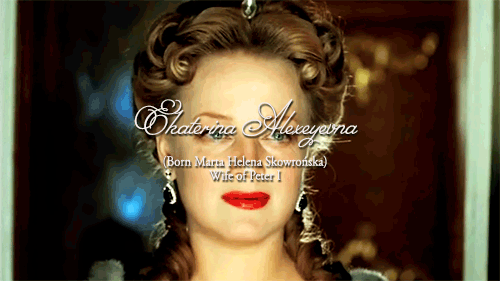
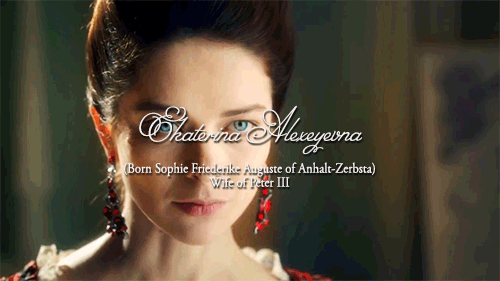
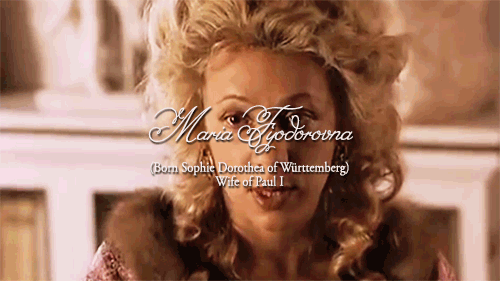
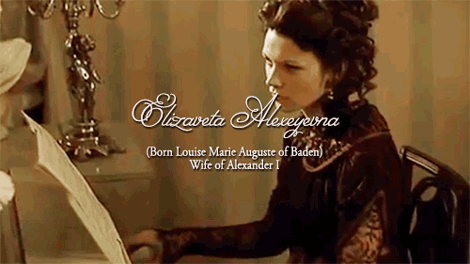
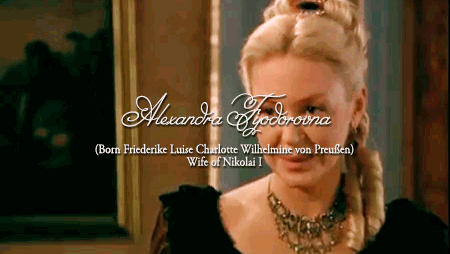
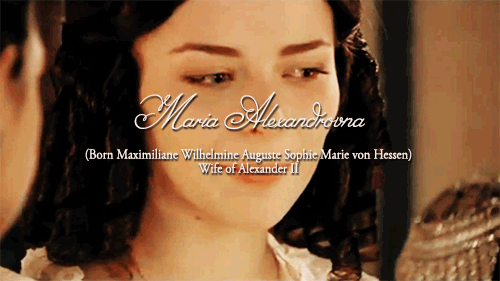
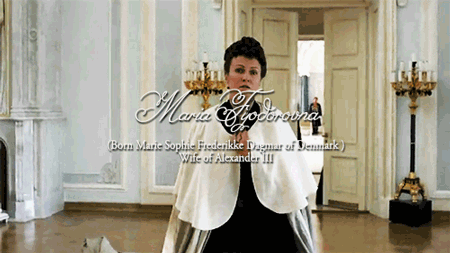
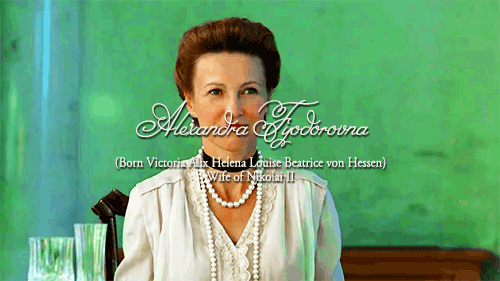
EMPRESS-CONSORTS OF RUSSIA
Ekaterina Alexeyevna (born Marta Helena Skowrońska). Married Tsar Peter I on February 19, 1712. Became Empress(-Consort) when Peter I took on the title of Emperor in 1721. After her husband’s death on January 28, 1725, she became Empress-Regnant, known as Catherine I, until her death on May 6, 1727.
Ekaterina Alexeyevna (born Sophie Friederike Auguste von Anhalt-Zerbst-Dornburg). Married Grand Duke Pyotr Fyodorovich on August 21, 1745. Empress-Consort to Peter III (January 5 1762 – July 9, 1762). After leading a coup d’etat that saw the abdication and assassination of her husband, she proclaimed herself Empress-Regnant and ruled as an autocrat for 34 years until her death.
Maria Fyodorovna (born Sophie Dorothea of Württemberg). Married Grand Duke Pavel Petrovich on September 26, 1776. (She was Paul’s second wife. His first wife, Natalia, had died in childbirth.) Empress-Consort to Paul I (November 17, 1796 – March 23, 1801). After Paul I’s assassination in a coup d’etat, Maria retained her status of the first lady of the empire, outranking the Empress-Consort Elizaveta Alexeyevna. She outlived not only her husband, but several of her children, including Emperor Alexander I and his wife, and died at age 69 in 1828.
Elizaveta Alexeyevana (born Louise Marie Auguste of Baden), Married Grand Duke Alexander Pavlovich on September 28, 1793. (They were both very young - 14 and 15 years old, respectively.) Empress-Consort to Alexander I (March 24 1801 – December 1, 1825). She outlived her husband by 5 months.
Alexandra Fyodorovna (born Friederike Luise Charlotte Wilhelmine von Preußen). Married Grand Duke Nikolai Pavlovich on July 13, 1817 (incidentally her birthday.) Empress-Consort to Nikolai I (December 1, 1825 – March 2, 1855). She outlived her husband by 5 years.
Maria Alexandrovna (born Maximilianne Wilhelmine Auguste Sophie Marie von Hessen). Married Grand Duke Alexander Nikolaevich on April 28, 1841. Empress-Consort to Alexander II (March 2, 1855 – June 3, 1880).
Maria Fyodorovna (born Marie Sophie Frederikke Dagmar of Denmark). She was originally engaged to Tsesarevich Nikolai Alexandrovich, her future husband’s older brother, but Nikolai died of meningitis before their wedding. Maria married Grand Duke Alexander Alexandrovich on November 9, 1866. Empress-Consort to Alexander III (March 13, 1881 – November 1, 1894). She outlived her husband by 34 years; she also survived the Russian Revolution and died in Denmark in 1928.
Alexandra Fyodorovna (born Victoria Alix Helena Louise Beatrice von Hessen). Married Nikolai II on November 26, 1894 and was Empress-Consort from that day until March 15, 1917. She was assassinated with the rest of her family on July 17, 1918.
#perioddramaedit#russian empire#Russia#historyedit#romanovs#grigoriy r#poor nastya#tdp#catherine (2014)#mathilde#poor poor paul#empress consorts of russia#op#my gifs
249 notes
·
View notes
Text
Book review: Romanov
By: Nadine Brandes
Published: 2019
When I first started this book, I decided to have a completely open mind. You may know that the topic of the last Russian Imperial family is my main topic of historical research and I have spent countless hours in the past 12 years reading, writing and talking about them. And so I dare say I have a considerable knowledge of their characters, living conditions, anecdotes and other trivia. And the more i know the less tolerant I tend to be to mistakes and inaccuracies when it comes to fictional representations of them. Still, I realize I too was charmed by the Anastasia cartoon when I was a kid and I also know it would be wrong and hypocritical from me to just condemn this book when I enjoyed My Lady Jane.
All in all, this is not a bad book. Better than I had feared, most definitely. The writing holds a promise with bits of brilliance winking at the reader from here and there. The pacing is good. The author uses the actual facts a lot in the first half, even if sometimes chooses to twist the information to suit her needs. I can definitely see this as a book that can inspire young people to actually go and do some actual research on the Romanovs, and for that I am always grateful. Still, I honestly cannot let the simplified version of the events just go, neither can I completely forgive obliteration of certain characters and events. Here are just some things which bothered the nit-picky me:
Rasputin was shot by Russian aristocrats (including a member of the Imperial family, Grand Duke Dmitri Pavlovich), NOT by the Bolsheviks
for God´s sake would English authors STOP referring to Anastasia as Princess already??? She was not a Princess!!!!! Her title was that of Grand Duchess and as such ranked above “Princess”
Yakov Yurovski was the man who led the execution of the Romanovs. Not the man who brought them from Tobolsk to Ekaterinburg. That was Inspector Yakovlev - a fascinating and enigmatic figure, who may, and may have not, tried to actually save some of the members of the Imperial family. And Yurovsky... well, life really got back at him for everything he did, so the way his name is used in this book actually made me want to defend him a little :/
You would NEVER adress Alexei as “Tsarevich”. It would be “Your Highness”. And in reality…. he was called “Alexei Nikolaevich” by all the servants.
“They handed us to the Bolsheviks!” Erhm......... the Bolsheviks had you in the first place? Confused much? (though as this point I think the author just loves the word “Bolsheviks”.
Please, English authors. STOP inserting random Russian words into your English books. Goes for other foreign languages too.
Although many were never delivered, the Imperial family did exchange several letters during their time apart
The imperial party in the Ipatiev house also included a kitchen boy Sednev
Anastasia had some basics of German, but definitely not enough to read a book in that language. The author should have made the “book of spells” in French or English.
The White Army, though full of aristocrats, did not fight to put Nicholas II back on the throne. It was a sad state of affairs but hardly anyone really wanted him.
It is implied that the girls were never considered for marriage becuase of hemophilia. Untrue. Olga, Tatiana and Maria all received marriage proposals and there were avid discussions about their prospective husbands.
Tatiana does not seem to exist.
The girls (and Alexei) lost their hair due to measels medication in early 1917. Not to lice a month before they died!
“Maria was always more concerned about her looks than the rest of us”. HAHAHAHAHAHAHAHAHAHAHAHAHAHAHA. No.
The level of free intimacy between the girls and the soldiers in this book is just wrong. Because it would not have been permitted by either side. It makes light of the actual situation. The whole Ivan Skorokhodov romance is overplayed (but I wouldn´t mind this), just that..... he was not shot. He was simply sent away from the house. And nobody ever touched Maria or her sisters violently.
“Citizen Nikolai”. No. It would be “Citizen Romanov”. For the whole family.
I suppose my main issue with the whole magic plot is the fact that the Romanovs were extremely devout, and while believing in miracles 100%, they believed in God. This was such a huge part of their lives and personalities that to change it for the sake of a plot just feels wrong to me.
There is no evidence whatsoever that Alexandra and Rasputin were ever alone in a room together. And she never visited his flat.
I think the depiction of Alexei´s injuries and hemophilia are not well done in the second half of the book. It just seems.... trivialized. The boy would have died before they got him anywhere.
The dog, Joy, was left behind in Ekaterinburg, found by the White Army and eventually taken to England.
Considering the author herself, at the very end, acknowledges some of these inaccuracies... I just don´t understand why she let them stand. They did nothing to enrich the story and could have been left alone. The second half of the book, though full of action, lacked a storyline I would be eager to follow. It felt rather juvenile and the magic factor gained too much focus, sweeping away the reality and turning this tragedy into something inconsequential. At least that is how it felt to me.
Final rating: it was OK
35 notes
·
View notes
Text
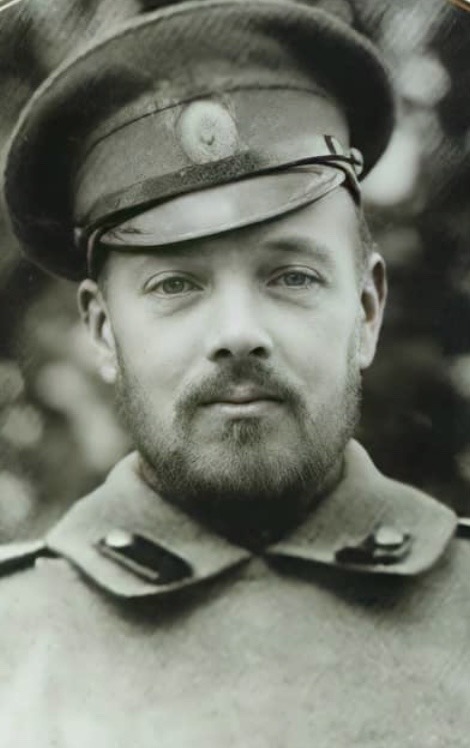
Grand Duke Sergei Mikhailovich (1869 - 1918)
Sergei Mikhailovich was the 5th son and 6th child of Grand Duke Mikhail Nikolaievich.
Sergei grew up to be an artillery man like his father and at one point would occupy the same position as his father in the Imperial Military hierarchy. He was intellectually bright but seems to have had a “variable” disposition which did not endear him to many. In his youth he had been in love with Grand Duchess Xenia Alexandrovna, who preferred to marry his brother Sandro instead.
When the future Tsar Nicholas II left his ballerina mistress to marry Alexandra, he charged Sergei with taking care of her and he did…as a matter of fact, he never stopped taking care of Mathilde, even assuming paternity for a son who was most likely fathered by Grand Duke Andrei Vladimirovich, the man Mathilde eventually married.
Sergei was dismissed from his powerful position in the military amidst scandalous rumors involving Mathilde and the illegal sale of weapons, etc. In the Spring of 1918 he was brutally murdered by the Bolsheviks, along Grand Duchess Elizabeth Feodorovna.
You may not know some things about him: 1. Enjoyed choral music and sang in a choir that he supported and rehearsed at the New Mikhailosky Palace, where Sergei lived with his brother Nikolai.
2. Towards the end of his life he suffered greatly from bone pain probably related to rheumatoid arthritis
3. Most likely than not he had an illegitimate son by Countess Barbara Vorontzova-Daskova, née Orlova, the widow of Count Ivan Illarionovitch Vorontzov-Daskov (1866–1897). The child was adopted by a friend of his mother, Sophia Vladimirovna Dehn. There was never a relationship between father and son
4. He would probably have been able to leave Saint Petersburg in time to avoid being murdered but he stayed behind when Mathilde left to take care of her financial affairs
5. Among the objects on his body after his murder, there was a gold pendant in the shape of a potato on a gold chain, the emblem of the "Potato club “ which Tsarevich Nicholas, Sergei, some of his brothers and friends had formed in the days of their youth. There was also a small gold medallion with an emerald in the middle, which had been a present to Sergei from Mathilde many years earlier. It contained her portrait
6. Of all the children of Grand Duke Mikhail Nikolaevich, Serge was the only one who had blue eyes, inherited all the way back from his great-grandfather Tsar Pavel.
#russian history#imperial russia#nicholas ii#romanov family#vintage photography#mathilde kschessinska#grand duke sergei alexandrovich#Barbara vorontsova-dashkova#grand duke mikhail nicholaievich#grand duke andrei vladimirovich#grand duchess xenia alexandrovna
24 notes
·
View notes
Text

On the image: on the left: the Grand Duke Mikhail Alexandrovich, and on the right, P. L. Znamerovsky the head of the gendarme department of the Baltic railway roads who lived in Gatchina where Mikhail Alexandrovich lived too. (Perm, March 1918)
Not Mr. Johnson but P. L. Znamerovsky
One of the most intriguing discoveries that I made in my research and investigation of the case of the disappearance of Nicolas II and his Family was in connection to the Grand Duke Mikhail Alexandrovich and the photograph that is shown and included into many sites and publications - see the photograph attached to the post.
Contrary to prior belief, Mikhail Alexandrovich is pictured on this photo NOT with his secretary Nikolai Nikolaevich Jonson (Johnson), but with P. L. Znamerovsky, the head of the gendarme department of the Baltic railway roads who lived in Gatchina where Mikhail Alexandrovich lived too.
The original photograph does not state the name of the person but has a writing at the back:
'April 9 - 1918 - Perm. We had our photograph taken at the Hay Market, while walking around the city. The photo was developed in 19 minutes. Signature. I haven’t shaved since the day I left Gatchina (February 22 – March 7)'
The clarification of who is on the photograph with Mikhail Alexandrovich is made by a note N198 which is attached to the case F. R9440. Op.1 D.1. (GARF)
It says: 'To the judicial investigator for the most important cases. In addition to my request, I ask you to notify me if the corpses of Znamerovsky and Lebedeva are identified. I am enclosing a photo of P. L. Znamerovsky taken together with the Grand Duke Mikhail Alexandrovich. When the need has passed, I humbly ask you to return the photo to me or to the relatives of P. L. Znamerovsky: his son, brother and sister live in Petrograd. The photo was taken by some amateur in March 1918, apparently at the Hay Market. K. A. Simonova. Address: Kungurskaya, 8, apt. 1'
The above information was discovered in the GARF archives, in the case F. R9440. Op.1 D.1., by Ilya Chishko in September 2016. Of his discovery he informed a journalist Lubov Markova who wrote an article about it in the magazine 'New Companion' dated 20 March 2018.

On the image: On the left: Natalia Sergeevna Brasova, the wife of the Grand Duke Mikhail Alexandrovich, and Mikhail Alexandrovich, far right - Nikolai Nikolaevich Jonson (Johnson), the secretary of the Grand Duke Mikhail Alexandrovich (Nice, France)
#romanovs#research#seraphima bogomolova#investigation#photographs#murder mystery#Mikhail Alexandrovich#Nikolai Nikolaevich Johnson#Nice#Brasova
2 notes
·
View notes
Text

Grand Duke Nikolai Nikolaevich in The Tatler, January 1915.
The title seems insulting, but the article is actually complimentary!
#romanov#nikolaevichi#nikolai nikolaevich the younger#nikolai nikolaevich#nikolasha#old magazines#my collection
8 notes
·
View notes